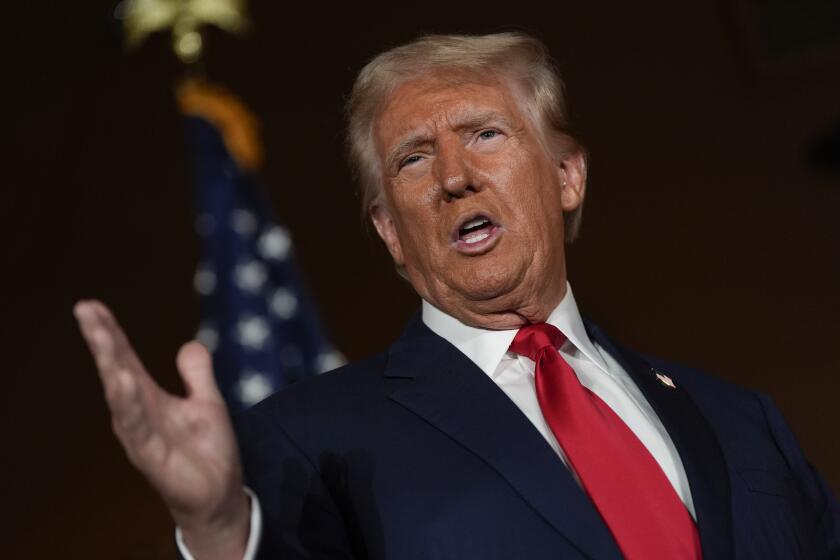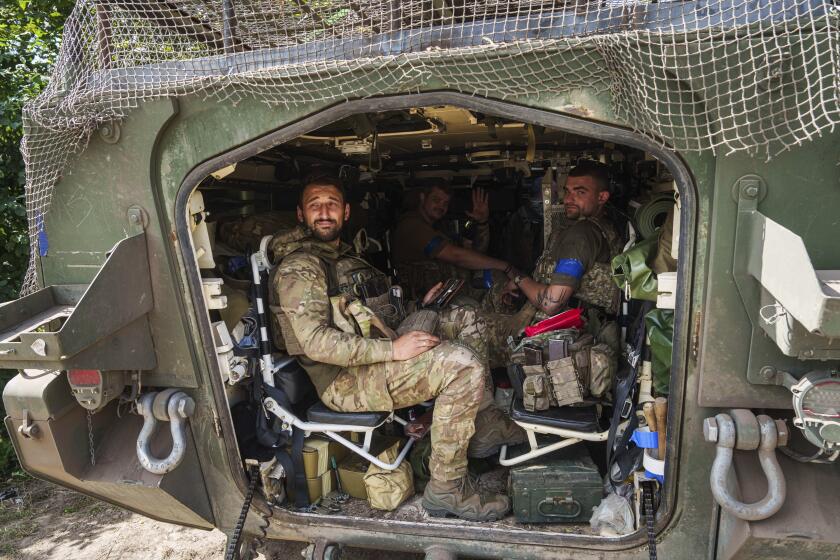Containment Has Run Its Course
Critics of the use of force against Saddam Hussein say the Iraqi leader can instead be contained. They concede he’s a murderous despot but contend that he’s not suicidal. They believe that if Hussein launched a chemical, biological or nuclear attack against Israel, other neighbors or the U.S., he would invite devastating retaliation. As a result, he is deterred from using his weapons of mass destruction as instruments to achieve regional dominance, in the same way that the Soviet Union was discouraged from using its nuclear weapons during the Cold War.
But the Sept. 11 attacks have severely undercut containment as a way to handle Hussein, for many reasons. The terrorist attacks on America highlighted dangerous new realities. Geography no longer protects the United States. Individuals and groups are prepared to carry out mass murder against us without the slightest moral scruple; some are willing to sacrifice their own lives in doing so. Even more ominously, there is little reason to believe that the Sept. 11 attackers would not have used weapons of mass destruction had they possessed them.
Saddam Hussein’s Iraq has long served as a safe harbor for terrorists, even if the exact nature of its links to Al Qaeda remains murky. Last week, National Security Advisor Condoleezza Rice revealed that high-ranking Al Qaeda detainees have acknowledged that Iraq trained some of their members in the development of chemical weapons. Iraq has maintained a terrorist facility at Salman Pak near Baghdad, where an old Boeing 707 passenger airplane is used in training hijackers. The regime sheltered the notorious terrorist Abu Nidal, whose “suicide” was recently announced by Baghdad, and, in 1993, Iraq tried to assassinate former President Bush during a trip to Kuwait.
Besides its ties to terrorists, Iraq has produced large quantities of potential terrorist weapons, among them the deadly VX nerve gas and weaponized anthrax. For more than two decades, Iraq has pursued a covert program to develop nuclear weapons. Given Hussein’s obsessive hatred of the United States, it would be irresponsible to assume that he would forgo an opportunity to supply terrorists with chemical or biological weapons, or even a nuclear device, for an attack on the U.S. if the origin of the weapon could be concealed.
Containment is a risky defense against a man of Hussein’s character. He rose through the ranks of the Baath Party as a hit man. He has brutalized his own country, possibly murdering as many as 200,000 people. He revels in the torture and execution of opponents, real or imagined, in his own military and party. Family members have been among his victims.
His tactical successes cannot conceal his penchant for dangerous miscalculation. In September 1980, he launched a war with Iran that nearly resulted in his own defeat. The eight-year conflict inflicted great damage on Iraq and killed as many as 1 million people in the two countries. He used chemical weapons against Iranians and his own population.
Before his march into Kuwait, Hussein threatened to “burn half of Israel.” In 1990-91, the invasion of Kuwait proved disastrous to him and his people when the Iraqi leader refused to withdraw after the U.S. assembled an international coalition and deployed overwhelming force in the Persian Gulf. During the Gulf War, he fired Scud missiles at Saudi Arabia and Israel. At other times, he has threatened Jordan. Arab diplomats report that Hussein’s staff gives him only the information he prefers to hear.
Is it not wishful thinking to hope that a man with this record can be relied upon to make the rational strategic calculations or exercise the restraint and prudence that advocates of deterrence and containment assume?
Finally, a policy of containment is no match for a nuclear capability in the hands of a man of Hussein’s character. The evidence of Hussein’s dogged pursuit of nuclear weapons is incontrovertible. Before they were thrown out of Iraq in 1998, U.N. inspection teams found evidence of a nuclear program whose size exceeded the estimates of even the most pessimistic foreign intelligence agencies. The findings made a mockery of the pre-1990 inspections by the International Atomic Energy Agency, which gave Iraq a clean bill of health.
To keep his nuclear program alive, Hussein has defied no fewer than 16 successive U.N. Security Council resolutions demanding his compliance with inspections. Iraq has forfeited some $150 billion in oil revenues because it has refused to meet its disarmament obligations. If U.N. economic sanctions, periodic punishment by U.S. and British airstrikes in the no-fly zone, and the heavy costs of noncompliance have not persuaded Hussein to abandon his nuclear program, why believe that he can be deterred once he actually has obtained the weapons?
And that day may not be far off. Hussein’s engineers have the ability to construct a nuclear weapon much more rapidly if Iraq can obtain enriched uranium or plutonium from foreign sources, such as the former Soviet Union or South Africa. In such a case, the best intelligence estimates suggest Hussein could have his nuclear weapon within a year, or even a matter of months. Still more ominously, the Federation of American Scientists has estimated that Iraq could construct its nuclear device in total secrecy.
A nuclear-armed Hussein would have been far harder to dislodge from Kuwait in 1991. Indeed, it’s doubtful that a military effort to oust him would even have been undertaken. A nuclear-armed Hussein today or in the near future could be counted on to bully his neighbors and strive to dominate the entire region. The ability of the U.S. or the United Nations to deter such action would be greatly reduced, for who would want to threaten to use force against a regime equipped with nuclear weapons and led by a dictator who has shown himself to be both ruthless and rash?
George F. Kennan, architect of the containment doctrine, writing more than half a century ago, envisioned a measured strategy to block the expansion of the Soviet Union until its communist leaders mellowed. Hussein shows no signs of mellowing. While there are undeniable risks in using force against him, the risks of doing nothing and of allowing him to acquire nuclear weapons, or to use his existing chemical and biological weapons, are more dire.
A policy of containment against Iraq assumes that time is on our side. In fact, time is running out.
More to Read
Sign up for Essential California
The most important California stories and recommendations in your inbox every morning.
You may occasionally receive promotional content from the Los Angeles Times.










